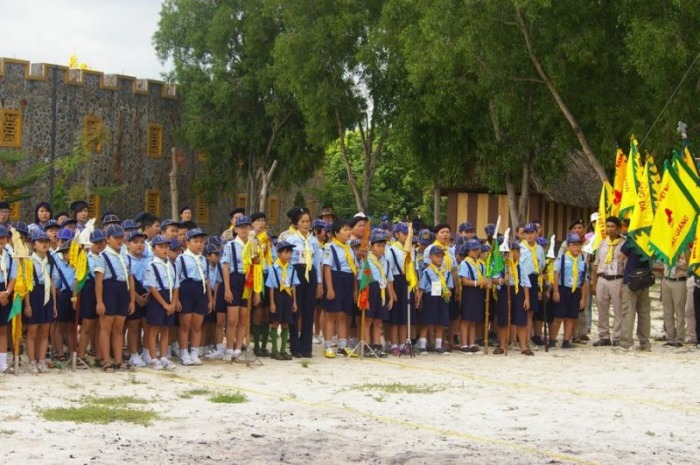|
Wolf Cubs (Baden-Powell Scouts' Association)
Wolf Cubs, usually referred to as Cubs, is the 3rd youngest section of Scouting operated by the Baden-Powell Scouts' Association, following on from the Beaver Scouts section. The core age range for Wolf Cubs is eight to eleven, though exceptions can be granted. Individual sections of Wolf Cubs, known as a Pack, are run by the local Scout Group. After reaching the age of ten and a half, a Wolf Cub may move on to Scouts Scouting, also known as the Scout Movement, is a worldwide youth movement employing the Scout method, a program of informal education with an emphasis on practical outdoor activities, including camping, woodcraft, aquatics, hiking, backpack .... History Wolf Cubs were established by Robert Baden-Powell in 1916, as a response to younger boys wishing to join the Scout Movement. Baden-Powell based the new programme on the Seonnee Pack, created in "The Jungle Book" by his friend Rudyard Kipling. Wolf Cubs still use "The Jungle Book" as a basis. Organisatio ... [...More Info...] [...Related Items...] OR: [Wikipedia] [Google] [Baidu] |
Baden-Powell Scouts' Association
The Baden-Powell Scouts' Association (''B-PSA'') is a worldwide youth organisation originating in the United Kingdom, with friendly relationships with similar traditional scouting organisations in various countries. Baden-Powell Scouting focuses on the importance of tradition in the scout movement. The Baden-Powell Scouts' Association shares the heritage of the youth scouting movement, however they believe in a traditional way of scouting which closely follows the programme set out by Lt. General Robert Baden-Powell in his book: ''Scouting for Boys''. The Baden-Powell Scouts' Association was formed in the United Kingdom in 1970 by the Reverend William Dowling when it was felt that the Scout Association was abandoning the traditions and intentions set out by Baden-Powell in 1908. The Baden-Powell Scouts retain the belief that the essence of the movement should be based on outdoor activities related to the skills of explorers, backwoodsmen and frontiersmen. It is a voluntary, no ... [...More Info...] [...Related Items...] OR: [Wikipedia] [Google] [Baidu] |
Scout Promise
The Scout Promise (or Oath) is a spoken statement made by a child joining the Scout movement. Since the publication of '' Scouting for Boys'' in 1908, all Scouts and Girl Guides around the world have taken a Scout (or Guide) promise or oath to live up to ideals of the movement, and subscribed to a Scout Law. The wording of the Scout Promise and Scout Law have varied slightly over time and from country to country. Although most Scouting and Guiding organizations use the word "promise", a few such as the Boy Scouts of America tend to use "oath" instead. Typically, Scouts and Guides will make the three-fingered Scout Sign when reciting the promise. Original 1908 text In his original book on Boy Scouting, Baden-Powell introduced the Scout Promise, as follows: World Organization of the Scout Movement requirements The form of the promise has varied slightly from country to country and over time, but must fulfill the requirements of the World Organization of the Scout Movement (WOSM) ... [...More Info...] [...Related Items...] OR: [Wikipedia] [Google] [Baidu] |
Cub Scout
Cub Scouts, Cubs or Wolf Cubs are programs associated with Scouting for young children usually between 7 and 12, depending on the organization to which they belong. A participant in the program is called a Cub. A group of Cubs is called a 'Pack'. The Wolf Cub program was originated by The Boy Scouts Association in the United Kingdom in 1916 to provide a program for boys who were too young to be Boy Scouts. It was adopted by many other Scouting organizations. Many Scouting organizations, including The Scout Association, no longer use the Wolf Cub program and have replaced it with other programs but have retained the name Cubs. Others, including Traditional Scouting organizations, maintain the original Wolf Cubs program. Originally Cubs programs were open only to boys, while young girls could join the Brownies. Some Cub organizations are open to both girls and boys, although not necessarily in the same unit. A few organizations also operate a Sea Cub version of Cubs. Found ... [...More Info...] [...Related Items...] OR: [Wikipedia] [Google] [Baidu] |
Seconder Cub Scouts Leadership Stripes, Monmouthshire Style
In deliberative bodies a second to a proposed motion is an indication that there is at least one person besides the mover that is interested in seeing the motion come before the meeting. It does not necessarily indicate that the seconder favors the motion. Purpose The purpose of requiring a second is to prevent time being wasted by the assembly's having to dispose of a motion that only one person wants to see introduced. Hearing a second to a motion is guidance to the chair that they should state the question on the motion, thereby placing it before the assembly. It does not necessarily indicate that the seconder favors the motion. Procedure The seconder may state "I second the motion" or "second" without first being recognized by the chair. They may remain seated but in larger assemblies, except in those where nonmembers may be seated in the hall, the seconder should stand. After hearing a second, the chair then states the question and the motion is placed before the assembly f ... [...More Info...] [...Related Items...] OR: [Wikipedia] [Google] [Baidu] |
Wolf Cub Seconder
The wolf (''Canis lupus''; plural, : wolves), also known as the gray wolf or grey wolf, is a large Canis, canine native to Eurasia and North America. More than thirty subspecies of Canis lupus, subspecies of ''Canis lupus'' have been recognized, and gray wolves, as popularly understood, comprise wild subspecies. The wolf is the largest Neontology, extant member of the family Canidae. It is also distinguished from other ''Canis'' species by its less pointed ears and muzzle, as well as a shorter torso and a longer tail. The wolf is nonetheless related closely enough to smaller ''Canis'' species, such as the coyote and the golden jackal, to produce fertile Canid hybrid, hybrids with them. The Agouti (coloration), banded fur of a wolf is usually mottled white, brown, gray, and black, although subspecies in the arctic region may be nearly all white. Of all members of the genus ''Canis'', the wolf is most Generalist and specialist species, specialized for Pack hunter, cooperativ ... [...More Info...] [...Related Items...] OR: [Wikipedia] [Google] [Baidu] |


.png)